Advanced Claims: Monitoring Performance and Recommendations
VerifiedAdded on 2023/04/08
|16
|3605
|237
AI Summary
This document discusses the management information used for monitoring the performance of claims in the insurance industry. It explores the effectiveness of various measures such as claim quantum, average time spent on claims, unit costs, and backlogs. Recommendations are provided for improving claim management through the use of technology. Subject: Insurance, Course Code: 1, Course Name: Advanced Claims, College/University: N/A
Contribute Materials
Your contribution can guide someone’s learning journey. Share your
documents today.

Advanced Claims 1
Advanced Claims
Advanced Claims
Secure Best Marks with AI Grader
Need help grading? Try our AI Grader for instant feedback on your assignments.

Advanced Claims 2
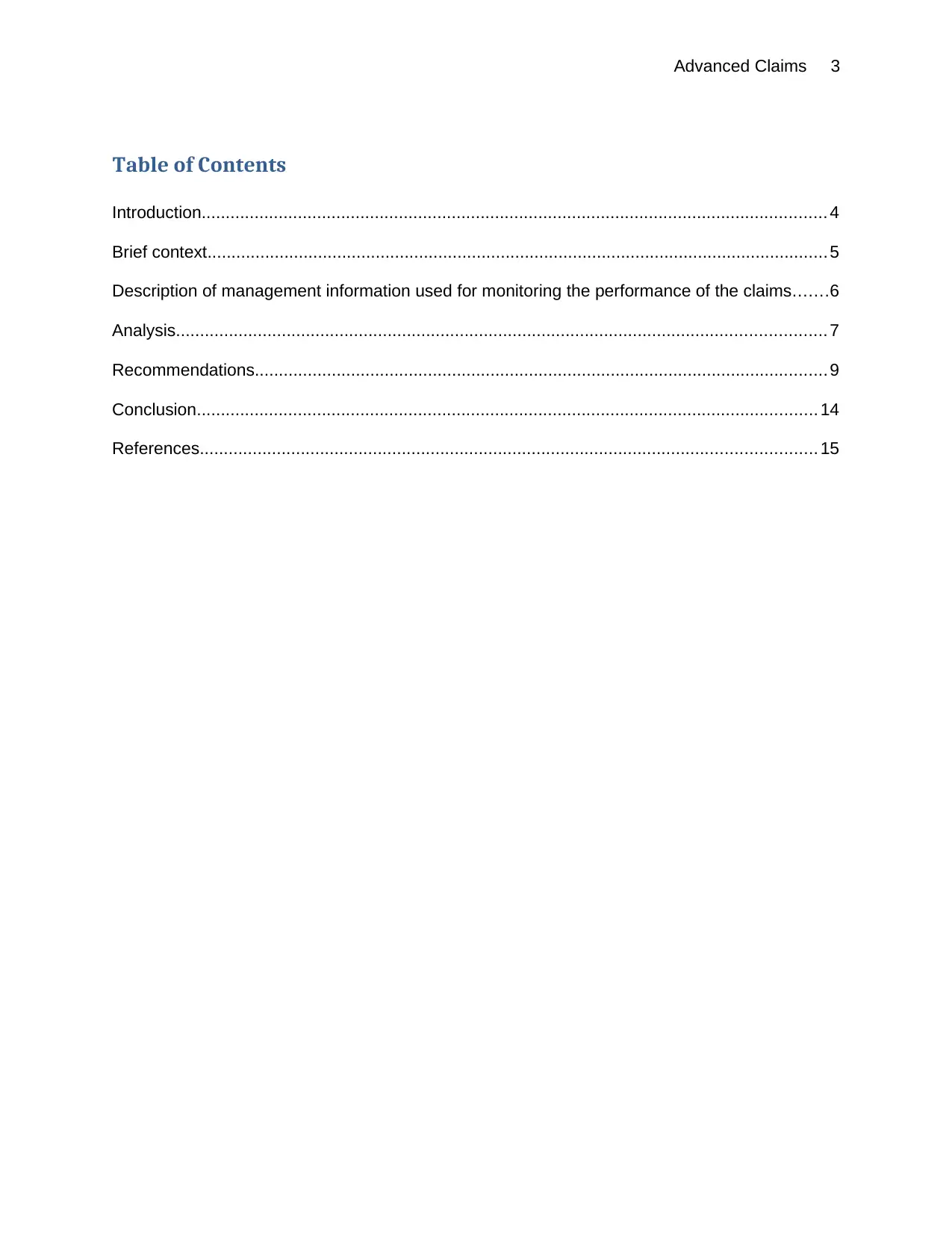
Advanced Claims 3
Table of Contents
Introduction.................................................................................................................................. 4
Brief context................................................................................................................................. 5
Description of management information used for monitoring the performance of the claims.......6
Analysis....................................................................................................................................... 7
Recommendations....................................................................................................................... 9
Conclusion................................................................................................................................. 14
References................................................................................................................................ 15
Table of Contents
Introduction.................................................................................................................................. 4
Brief context................................................................................................................................. 5
Description of management information used for monitoring the performance of the claims.......6
Analysis....................................................................................................................................... 7
Recommendations....................................................................................................................... 9
Conclusion................................................................................................................................. 14
References................................................................................................................................ 15
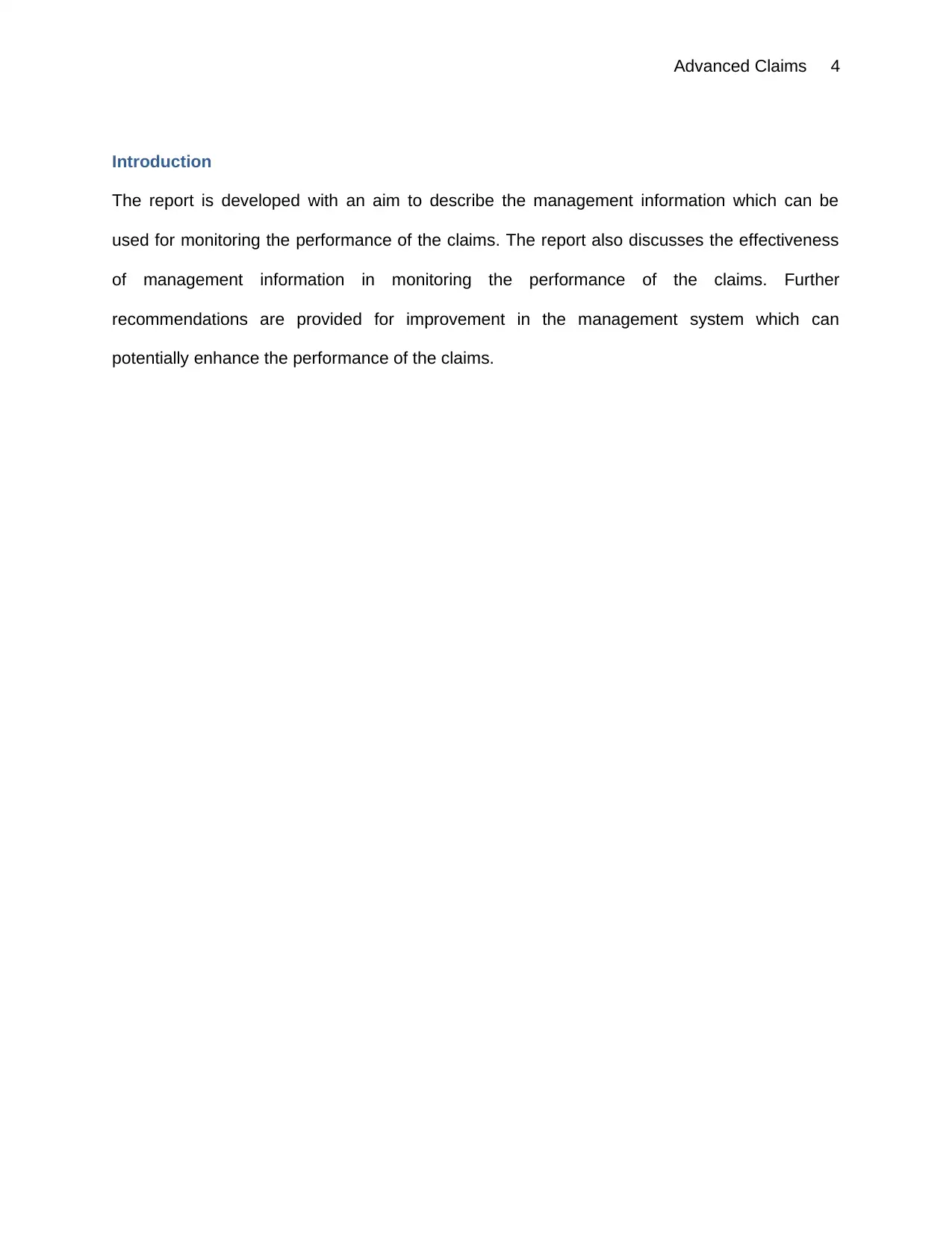
Advanced Claims 4
Introduction
The report is developed with an aim to describe the management information which can be
used for monitoring the performance of the claims. The report also discusses the effectiveness
of management information in monitoring the performance of the claims. Further
recommendations are provided for improvement in the management system which can
potentially enhance the performance of the claims.
Introduction
The report is developed with an aim to describe the management information which can be
used for monitoring the performance of the claims. The report also discusses the effectiveness
of management information in monitoring the performance of the claims. Further
recommendations are provided for improvement in the management system which can
potentially enhance the performance of the claims.
Secure Best Marks with AI Grader
Need help grading? Try our AI Grader for instant feedback on your assignments.
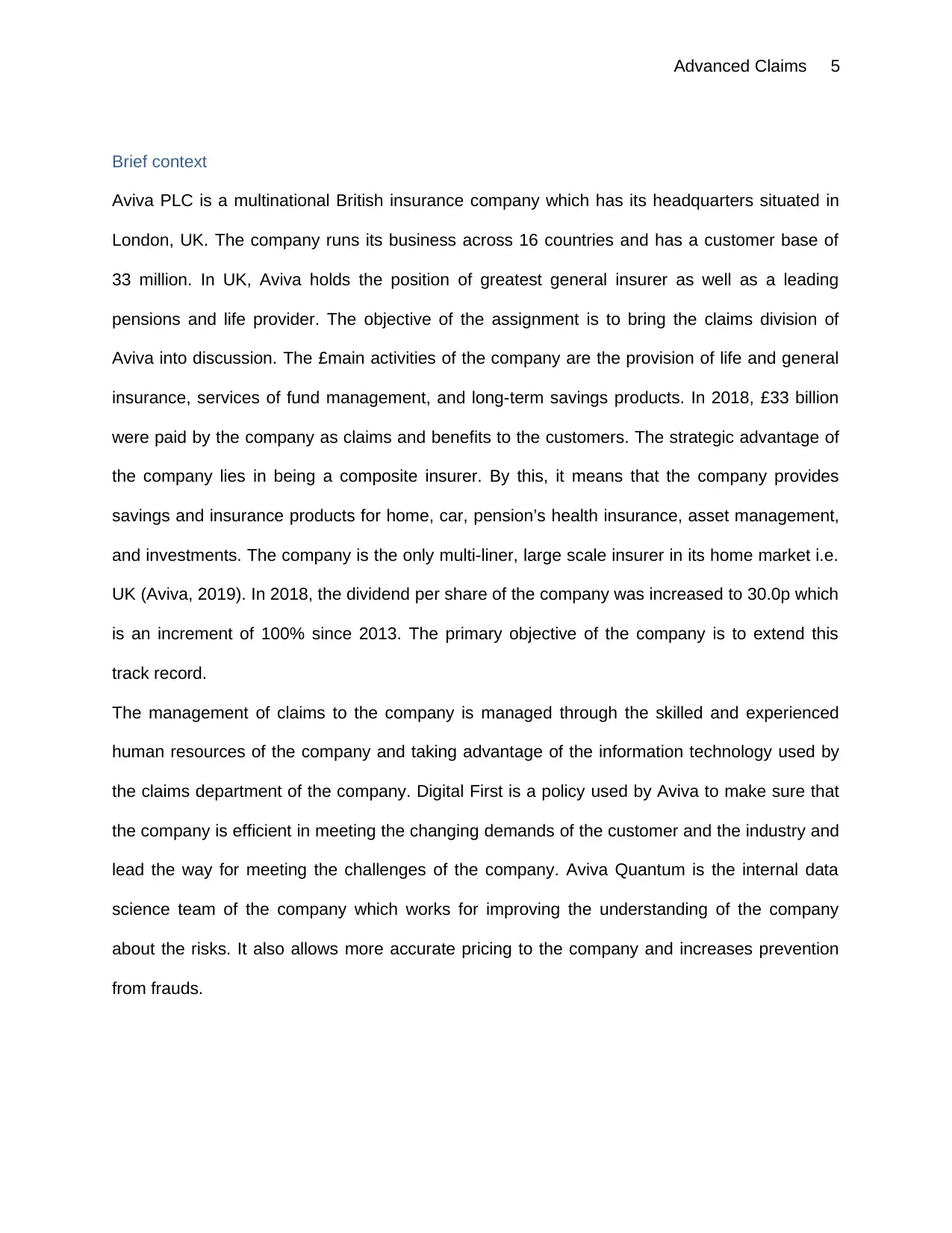
Advanced Claims 5
Brief context
Aviva PLC is a multinational British insurance company which has its headquarters situated in
London, UK. The company runs its business across 16 countries and has a customer base of
33 million. In UK, Aviva holds the position of greatest general insurer as well as a leading
pensions and life provider. The objective of the assignment is to bring the claims division of
Aviva into discussion. The £main activities of the company are the provision of life and general
insurance, services of fund management, and long-term savings products. In 2018, £33 billion
were paid by the company as claims and benefits to the customers. The strategic advantage of
the company lies in being a composite insurer. By this, it means that the company provides
savings and insurance products for home, car, pension’s health insurance, asset management,
and investments. The company is the only multi-liner, large scale insurer in its home market i.e.
UK (Aviva, 2019). In 2018, the dividend per share of the company was increased to 30.0p which
is an increment of 100% since 2013. The primary objective of the company is to extend this
track record.
The management of claims to the company is managed through the skilled and experienced
human resources of the company and taking advantage of the information technology used by
the claims department of the company. Digital First is a policy used by Aviva to make sure that
the company is efficient in meeting the changing demands of the customer and the industry and
lead the way for meeting the challenges of the company. Aviva Quantum is the internal data
science team of the company which works for improving the understanding of the company
about the risks. It also allows more accurate pricing to the company and increases prevention
from frauds.
Brief context
Aviva PLC is a multinational British insurance company which has its headquarters situated in
London, UK. The company runs its business across 16 countries and has a customer base of
33 million. In UK, Aviva holds the position of greatest general insurer as well as a leading
pensions and life provider. The objective of the assignment is to bring the claims division of
Aviva into discussion. The £main activities of the company are the provision of life and general
insurance, services of fund management, and long-term savings products. In 2018, £33 billion
were paid by the company as claims and benefits to the customers. The strategic advantage of
the company lies in being a composite insurer. By this, it means that the company provides
savings and insurance products for home, car, pension’s health insurance, asset management,
and investments. The company is the only multi-liner, large scale insurer in its home market i.e.
UK (Aviva, 2019). In 2018, the dividend per share of the company was increased to 30.0p which
is an increment of 100% since 2013. The primary objective of the company is to extend this
track record.
The management of claims to the company is managed through the skilled and experienced
human resources of the company and taking advantage of the information technology used by
the claims department of the company. Digital First is a policy used by Aviva to make sure that
the company is efficient in meeting the changing demands of the customer and the industry and
lead the way for meeting the challenges of the company. Aviva Quantum is the internal data
science team of the company which works for improving the understanding of the company
about the risks. It also allows more accurate pricing to the company and increases prevention
from frauds.
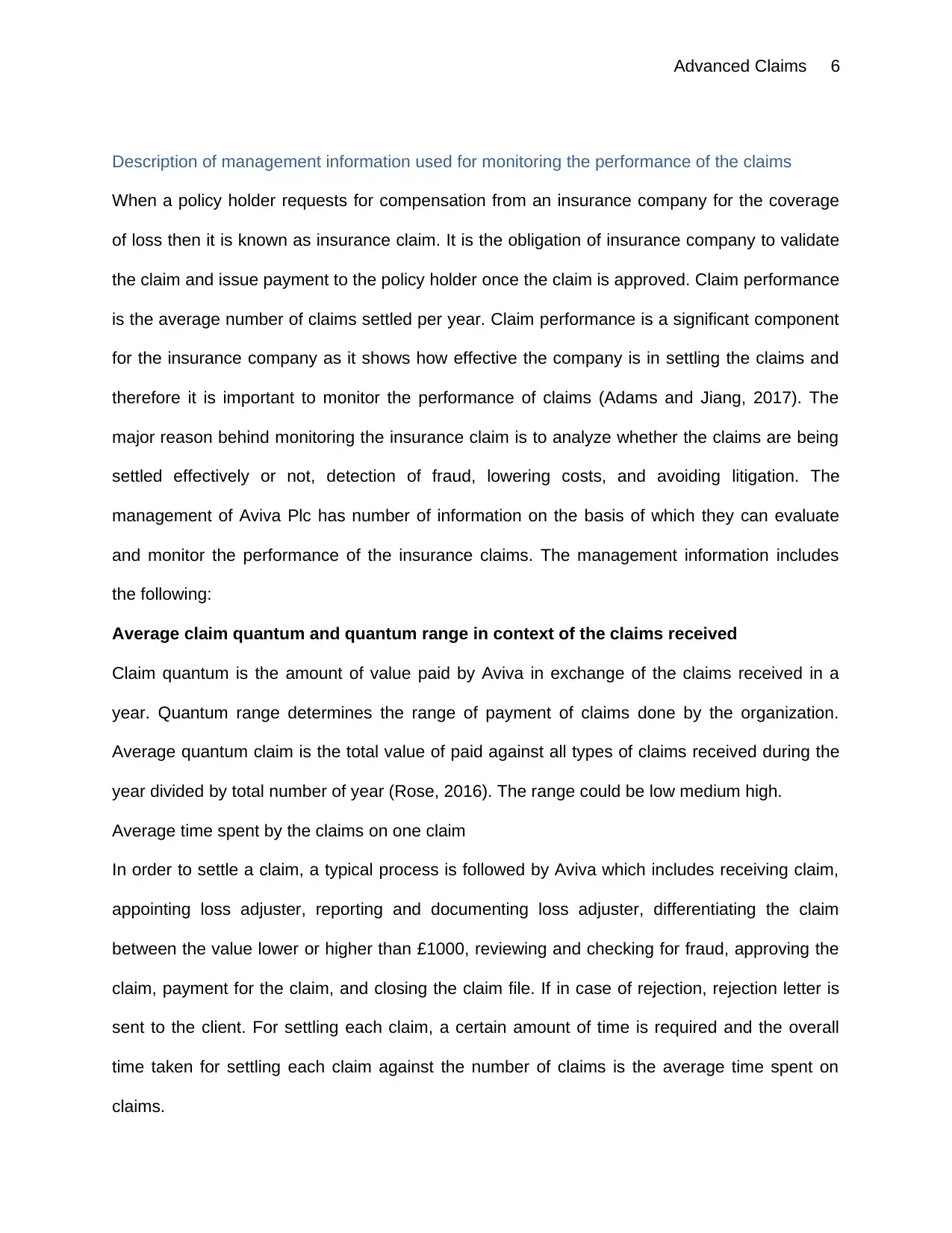
Advanced Claims 6
Description of management information used for monitoring the performance of the claims
When a policy holder requests for compensation from an insurance company for the coverage
of loss then it is known as insurance claim. It is the obligation of insurance company to validate
the claim and issue payment to the policy holder once the claim is approved. Claim performance
is the average number of claims settled per year. Claim performance is a significant component
for the insurance company as it shows how effective the company is in settling the claims and
therefore it is important to monitor the performance of claims (Adams and Jiang, 2017). The
major reason behind monitoring the insurance claim is to analyze whether the claims are being
settled effectively or not, detection of fraud, lowering costs, and avoiding litigation. The
management of Aviva Plc has number of information on the basis of which they can evaluate
and monitor the performance of the insurance claims. The management information includes
the following:
Average claim quantum and quantum range in context of the claims received
Claim quantum is the amount of value paid by Aviva in exchange of the claims received in a
year. Quantum range determines the range of payment of claims done by the organization.
Average quantum claim is the total value of paid against all types of claims received during the
year divided by total number of year (Rose, 2016). The range could be low medium high.
Average time spent by the claims on one claim
In order to settle a claim, a typical process is followed by Aviva which includes receiving claim,
appointing loss adjuster, reporting and documenting loss adjuster, differentiating the claim
between the value lower or higher than £1000, reviewing and checking for fraud, approving the
claim, payment for the claim, and closing the claim file. If in case of rejection, rejection letter is
sent to the client. For settling each claim, a certain amount of time is required and the overall
time taken for settling each claim against the number of claims is the average time spent on
claims.
Description of management information used for monitoring the performance of the claims
When a policy holder requests for compensation from an insurance company for the coverage
of loss then it is known as insurance claim. It is the obligation of insurance company to validate
the claim and issue payment to the policy holder once the claim is approved. Claim performance
is the average number of claims settled per year. Claim performance is a significant component
for the insurance company as it shows how effective the company is in settling the claims and
therefore it is important to monitor the performance of claims (Adams and Jiang, 2017). The
major reason behind monitoring the insurance claim is to analyze whether the claims are being
settled effectively or not, detection of fraud, lowering costs, and avoiding litigation. The
management of Aviva Plc has number of information on the basis of which they can evaluate
and monitor the performance of the insurance claims. The management information includes
the following:
Average claim quantum and quantum range in context of the claims received
Claim quantum is the amount of value paid by Aviva in exchange of the claims received in a
year. Quantum range determines the range of payment of claims done by the organization.
Average quantum claim is the total value of paid against all types of claims received during the
year divided by total number of year (Rose, 2016). The range could be low medium high.
Average time spent by the claims on one claim
In order to settle a claim, a typical process is followed by Aviva which includes receiving claim,
appointing loss adjuster, reporting and documenting loss adjuster, differentiating the claim
between the value lower or higher than £1000, reviewing and checking for fraud, approving the
claim, payment for the claim, and closing the claim file. If in case of rejection, rejection letter is
sent to the client. For settling each claim, a certain amount of time is required and the overall
time taken for settling each claim against the number of claims is the average time spent on
claims.
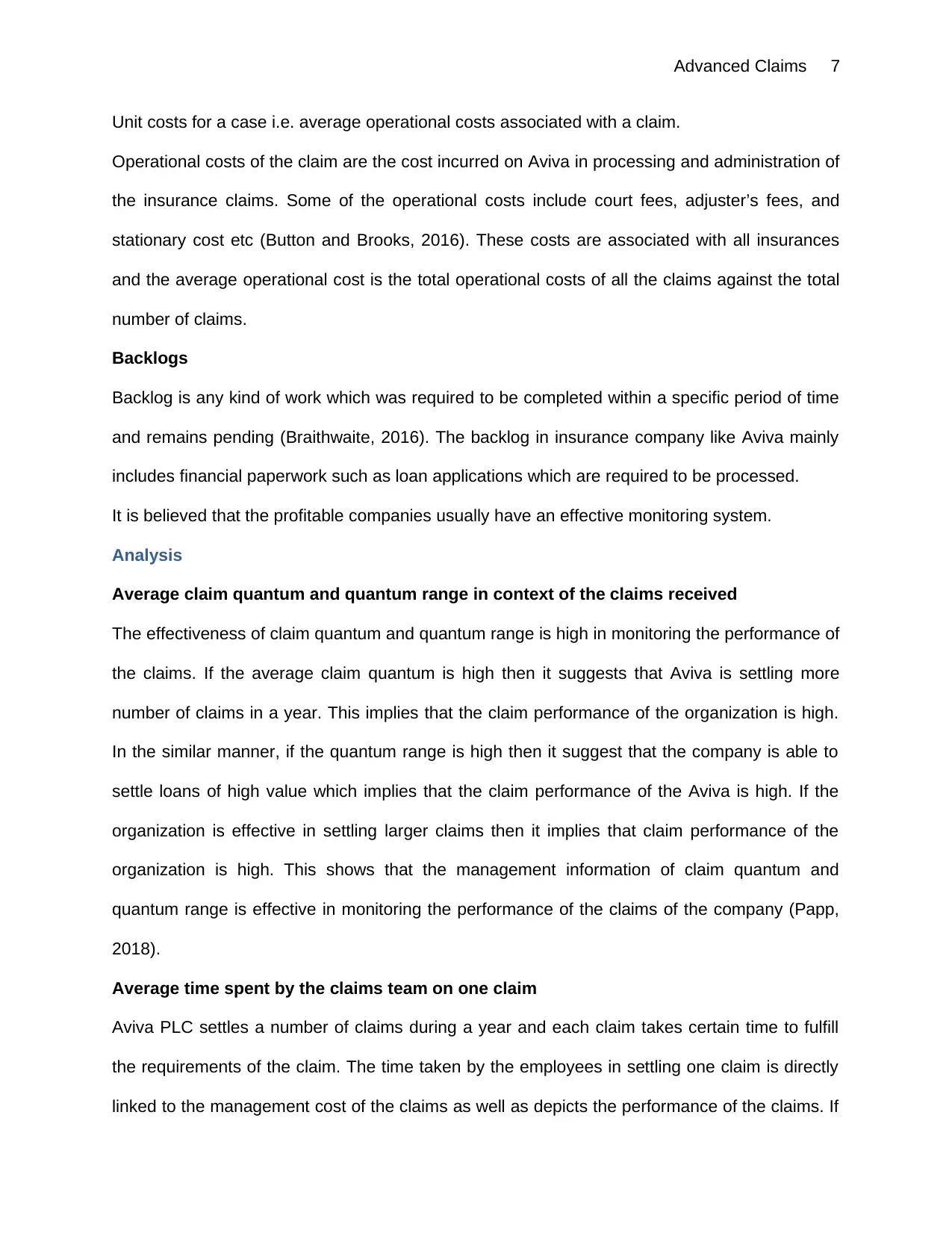
Advanced Claims 7
Unit costs for a case i.e. average operational costs associated with a claim.
Operational costs of the claim are the cost incurred on Aviva in processing and administration of
the insurance claims. Some of the operational costs include court fees, adjuster’s fees, and
stationary cost etc (Button and Brooks, 2016). These costs are associated with all insurances
and the average operational cost is the total operational costs of all the claims against the total
number of claims.
Backlogs
Backlog is any kind of work which was required to be completed within a specific period of time
and remains pending (Braithwaite, 2016). The backlog in insurance company like Aviva mainly
includes financial paperwork such as loan applications which are required to be processed.
It is believed that the profitable companies usually have an effective monitoring system.
Analysis
Average claim quantum and quantum range in context of the claims received
The effectiveness of claim quantum and quantum range is high in monitoring the performance of
the claims. If the average claim quantum is high then it suggests that Aviva is settling more
number of claims in a year. This implies that the claim performance of the organization is high.
In the similar manner, if the quantum range is high then it suggest that the company is able to
settle loans of high value which implies that the claim performance of the Aviva is high. If the
organization is effective in settling larger claims then it implies that claim performance of the
organization is high. This shows that the management information of claim quantum and
quantum range is effective in monitoring the performance of the claims of the company (Papp,
2018).
Average time spent by the claims team on one claim
Aviva PLC settles a number of claims during a year and each claim takes certain time to fulfill
the requirements of the claim. The time taken by the employees in settling one claim is directly
linked to the management cost of the claims as well as depicts the performance of the claims. If
Unit costs for a case i.e. average operational costs associated with a claim.
Operational costs of the claim are the cost incurred on Aviva in processing and administration of
the insurance claims. Some of the operational costs include court fees, adjuster’s fees, and
stationary cost etc (Button and Brooks, 2016). These costs are associated with all insurances
and the average operational cost is the total operational costs of all the claims against the total
number of claims.
Backlogs
Backlog is any kind of work which was required to be completed within a specific period of time
and remains pending (Braithwaite, 2016). The backlog in insurance company like Aviva mainly
includes financial paperwork such as loan applications which are required to be processed.
It is believed that the profitable companies usually have an effective monitoring system.
Analysis
Average claim quantum and quantum range in context of the claims received
The effectiveness of claim quantum and quantum range is high in monitoring the performance of
the claims. If the average claim quantum is high then it suggests that Aviva is settling more
number of claims in a year. This implies that the claim performance of the organization is high.
In the similar manner, if the quantum range is high then it suggest that the company is able to
settle loans of high value which implies that the claim performance of the Aviva is high. If the
organization is effective in settling larger claims then it implies that claim performance of the
organization is high. This shows that the management information of claim quantum and
quantum range is effective in monitoring the performance of the claims of the company (Papp,
2018).
Average time spent by the claims team on one claim
Aviva PLC settles a number of claims during a year and each claim takes certain time to fulfill
the requirements of the claim. The time taken by the employees in settling one claim is directly
linked to the management cost of the claims as well as depicts the performance of the claims. If
Paraphrase This Document
Need a fresh take? Get an instant paraphrase of this document with our AI Paraphraser
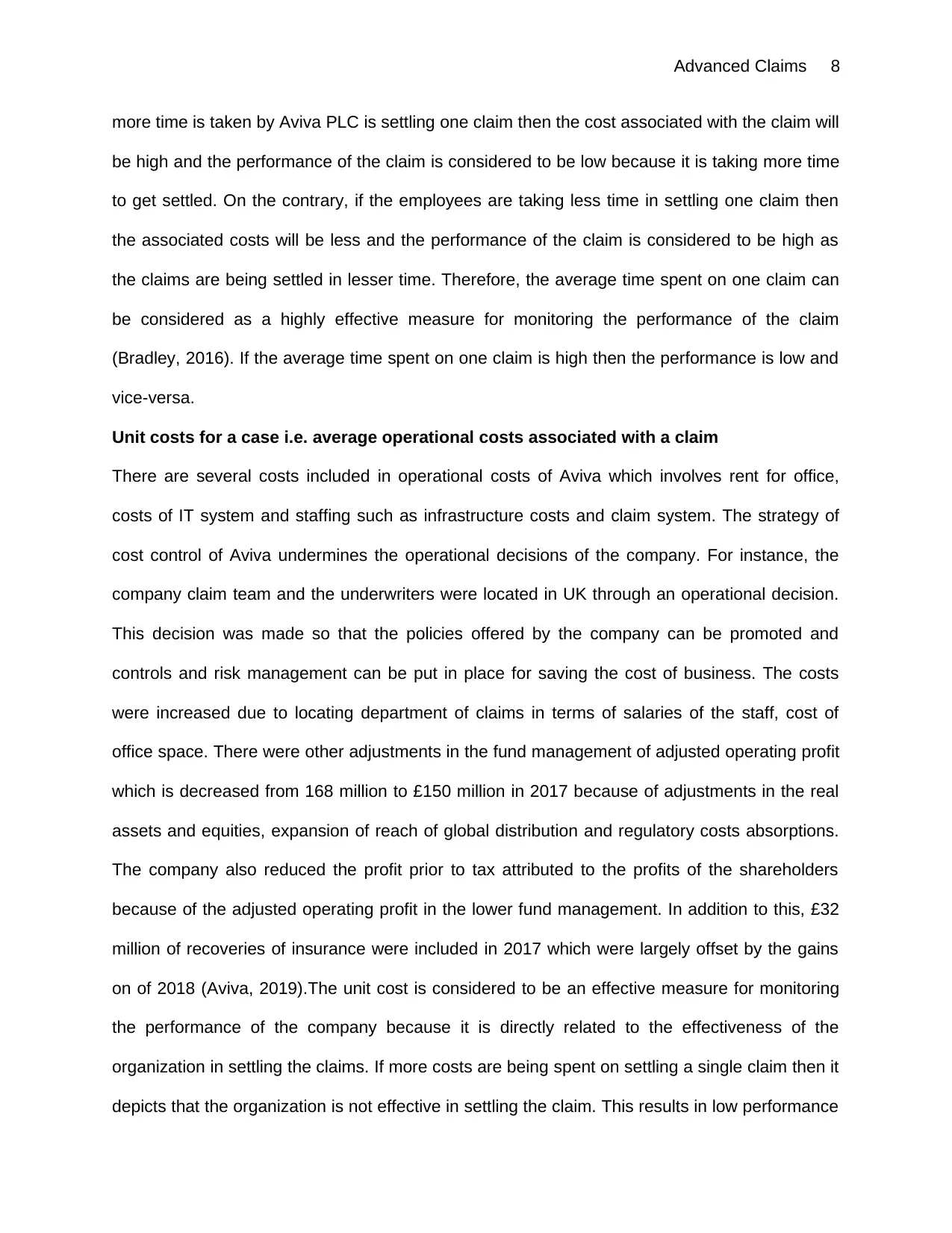
Advanced Claims 8
more time is taken by Aviva PLC is settling one claim then the cost associated with the claim will
be high and the performance of the claim is considered to be low because it is taking more time
to get settled. On the contrary, if the employees are taking less time in settling one claim then
the associated costs will be less and the performance of the claim is considered to be high as
the claims are being settled in lesser time. Therefore, the average time spent on one claim can
be considered as a highly effective measure for monitoring the performance of the claim
(Bradley, 2016). If the average time spent on one claim is high then the performance is low and
vice-versa.
Unit costs for a case i.e. average operational costs associated with a claim
There are several costs included in operational costs of Aviva which involves rent for office,
costs of IT system and staffing such as infrastructure costs and claim system. The strategy of
cost control of Aviva undermines the operational decisions of the company. For instance, the
company claim team and the underwriters were located in UK through an operational decision.
This decision was made so that the policies offered by the company can be promoted and
controls and risk management can be put in place for saving the cost of business. The costs
were increased due to locating department of claims in terms of salaries of the staff, cost of
office space. There were other adjustments in the fund management of adjusted operating profit
which is decreased from 168 million to £150 million in 2017 because of adjustments in the real
assets and equities, expansion of reach of global distribution and regulatory costs absorptions.
The company also reduced the profit prior to tax attributed to the profits of the shareholders
because of the adjusted operating profit in the lower fund management. In addition to this, £32
million of recoveries of insurance were included in 2017 which were largely offset by the gains
on of 2018 (Aviva, 2019).The unit cost is considered to be an effective measure for monitoring
the performance of the company because it is directly related to the effectiveness of the
organization in settling the claims. If more costs are being spent on settling a single claim then it
depicts that the organization is not effective in settling the claim. This results in low performance
more time is taken by Aviva PLC is settling one claim then the cost associated with the claim will
be high and the performance of the claim is considered to be low because it is taking more time
to get settled. On the contrary, if the employees are taking less time in settling one claim then
the associated costs will be less and the performance of the claim is considered to be high as
the claims are being settled in lesser time. Therefore, the average time spent on one claim can
be considered as a highly effective measure for monitoring the performance of the claim
(Bradley, 2016). If the average time spent on one claim is high then the performance is low and
vice-versa.
Unit costs for a case i.e. average operational costs associated with a claim
There are several costs included in operational costs of Aviva which involves rent for office,
costs of IT system and staffing such as infrastructure costs and claim system. The strategy of
cost control of Aviva undermines the operational decisions of the company. For instance, the
company claim team and the underwriters were located in UK through an operational decision.
This decision was made so that the policies offered by the company can be promoted and
controls and risk management can be put in place for saving the cost of business. The costs
were increased due to locating department of claims in terms of salaries of the staff, cost of
office space. There were other adjustments in the fund management of adjusted operating profit
which is decreased from 168 million to £150 million in 2017 because of adjustments in the real
assets and equities, expansion of reach of global distribution and regulatory costs absorptions.
The company also reduced the profit prior to tax attributed to the profits of the shareholders
because of the adjusted operating profit in the lower fund management. In addition to this, £32
million of recoveries of insurance were included in 2017 which were largely offset by the gains
on of 2018 (Aviva, 2019).The unit cost is considered to be an effective measure for monitoring
the performance of the company because it is directly related to the effectiveness of the
organization in settling the claims. If more costs are being spent on settling a single claim then it
depicts that the organization is not effective in settling the claim. This results in low performance
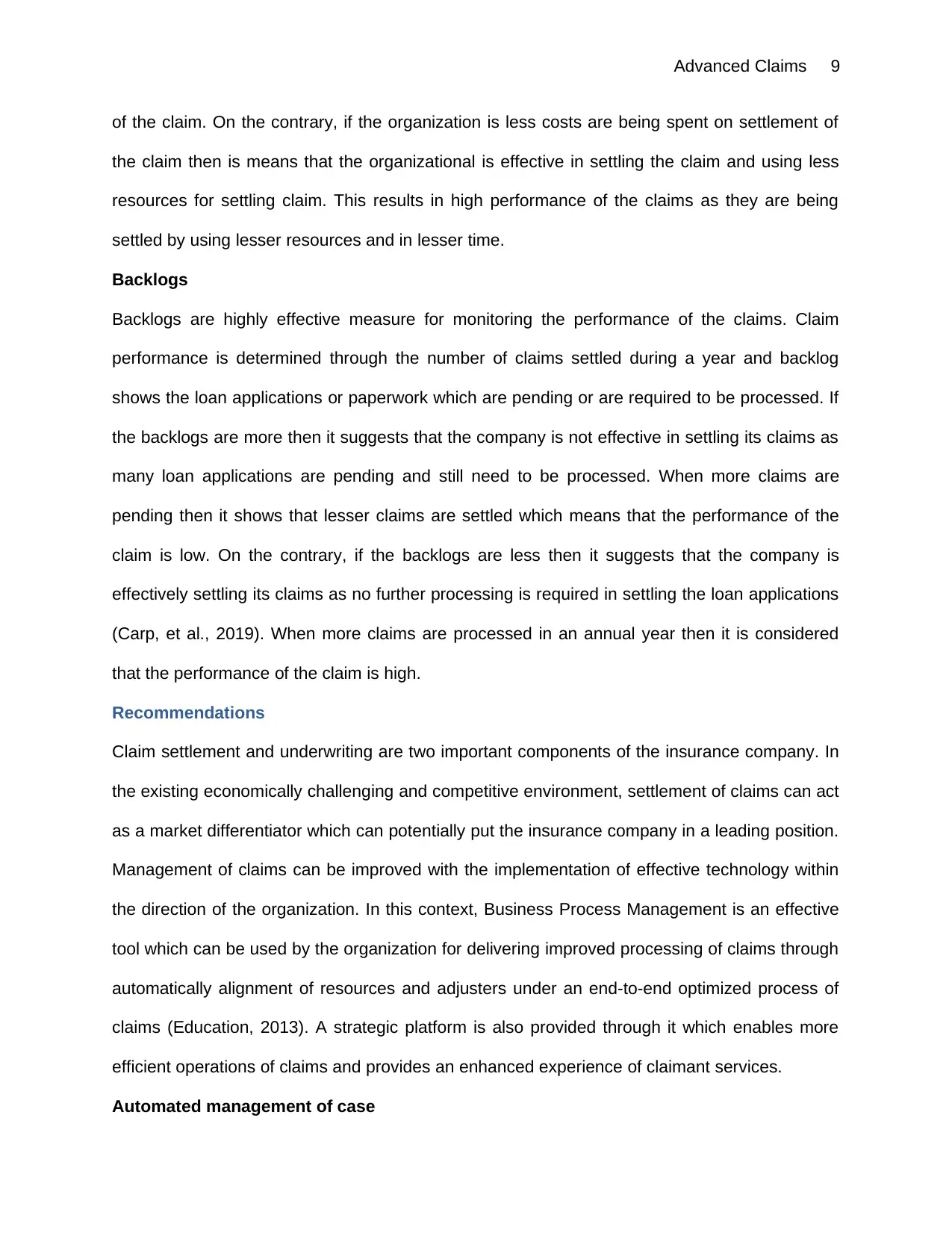
Advanced Claims 9
of the claim. On the contrary, if the organization is less costs are being spent on settlement of
the claim then is means that the organizational is effective in settling the claim and using less
resources for settling claim. This results in high performance of the claims as they are being
settled by using lesser resources and in lesser time.
Backlogs
Backlogs are highly effective measure for monitoring the performance of the claims. Claim
performance is determined through the number of claims settled during a year and backlog
shows the loan applications or paperwork which are pending or are required to be processed. If
the backlogs are more then it suggests that the company is not effective in settling its claims as
many loan applications are pending and still need to be processed. When more claims are
pending then it shows that lesser claims are settled which means that the performance of the
claim is low. On the contrary, if the backlogs are less then it suggests that the company is
effectively settling its claims as no further processing is required in settling the loan applications
(Carp, et al., 2019). When more claims are processed in an annual year then it is considered
that the performance of the claim is high.
Recommendations
Claim settlement and underwriting are two important components of the insurance company. In
the existing economically challenging and competitive environment, settlement of claims can act
as a market differentiator which can potentially put the insurance company in a leading position.
Management of claims can be improved with the implementation of effective technology within
the direction of the organization. In this context, Business Process Management is an effective
tool which can be used by the organization for delivering improved processing of claims through
automatically alignment of resources and adjusters under an end-to-end optimized process of
claims (Education, 2013). A strategic platform is also provided through it which enables more
efficient operations of claims and provides an enhanced experience of claimant services.
Automated management of case
of the claim. On the contrary, if the organization is less costs are being spent on settlement of
the claim then is means that the organizational is effective in settling the claim and using less
resources for settling claim. This results in high performance of the claims as they are being
settled by using lesser resources and in lesser time.
Backlogs
Backlogs are highly effective measure for monitoring the performance of the claims. Claim
performance is determined through the number of claims settled during a year and backlog
shows the loan applications or paperwork which are pending or are required to be processed. If
the backlogs are more then it suggests that the company is not effective in settling its claims as
many loan applications are pending and still need to be processed. When more claims are
pending then it shows that lesser claims are settled which means that the performance of the
claim is low. On the contrary, if the backlogs are less then it suggests that the company is
effectively settling its claims as no further processing is required in settling the loan applications
(Carp, et al., 2019). When more claims are processed in an annual year then it is considered
that the performance of the claim is high.
Recommendations
Claim settlement and underwriting are two important components of the insurance company. In
the existing economically challenging and competitive environment, settlement of claims can act
as a market differentiator which can potentially put the insurance company in a leading position.
Management of claims can be improved with the implementation of effective technology within
the direction of the organization. In this context, Business Process Management is an effective
tool which can be used by the organization for delivering improved processing of claims through
automatically alignment of resources and adjusters under an end-to-end optimized process of
claims (Education, 2013). A strategic platform is also provided through it which enables more
efficient operations of claims and provides an enhanced experience of claimant services.
Automated management of case
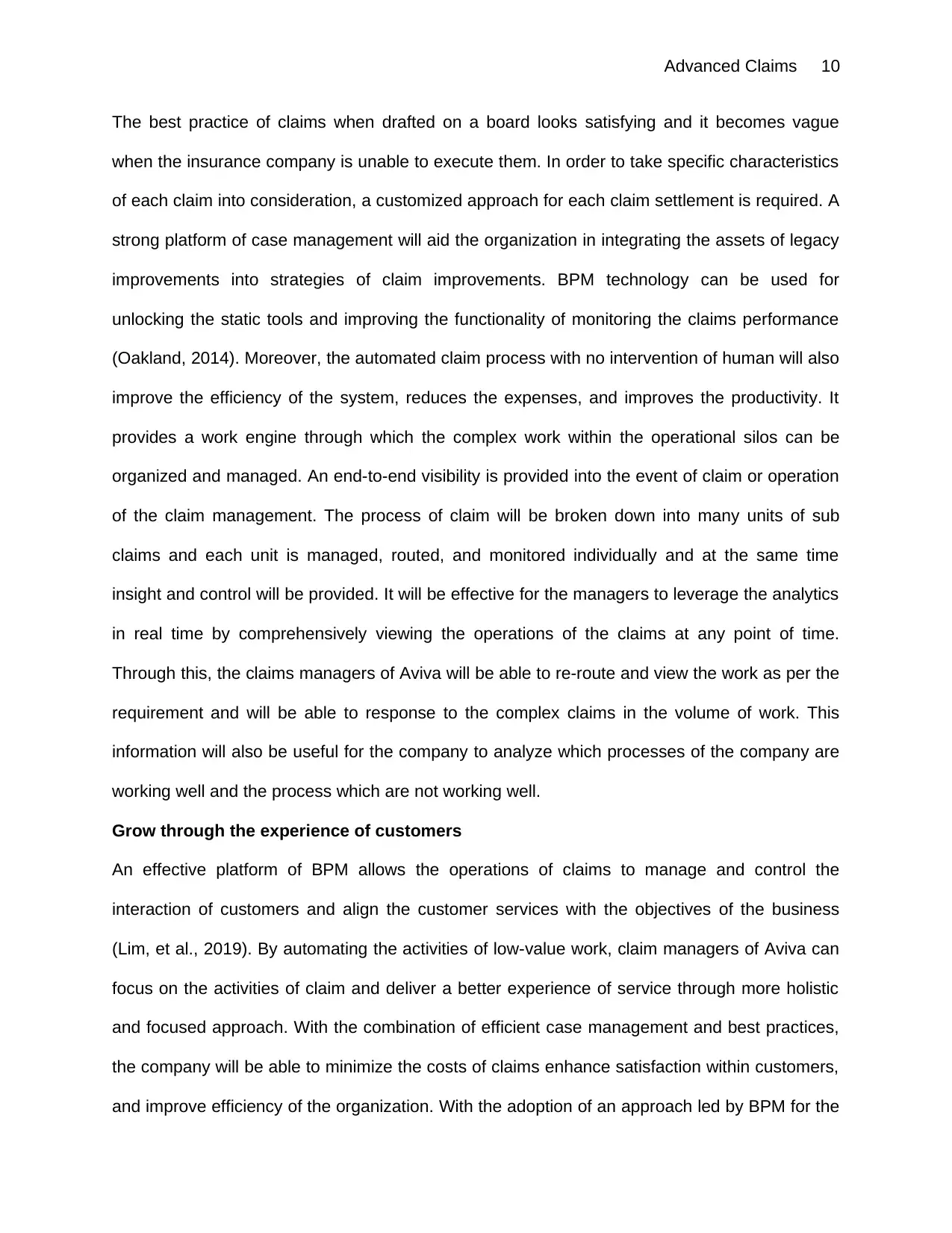
Advanced Claims 10
The best practice of claims when drafted on a board looks satisfying and it becomes vague
when the insurance company is unable to execute them. In order to take specific characteristics
of each claim into consideration, a customized approach for each claim settlement is required. A
strong platform of case management will aid the organization in integrating the assets of legacy
improvements into strategies of claim improvements. BPM technology can be used for
unlocking the static tools and improving the functionality of monitoring the claims performance
(Oakland, 2014). Moreover, the automated claim process with no intervention of human will also
improve the efficiency of the system, reduces the expenses, and improves the productivity. It
provides a work engine through which the complex work within the operational silos can be
organized and managed. An end-to-end visibility is provided into the event of claim or operation
of the claim management. The process of claim will be broken down into many units of sub
claims and each unit is managed, routed, and monitored individually and at the same time
insight and control will be provided. It will be effective for the managers to leverage the analytics
in real time by comprehensively viewing the operations of the claims at any point of time.
Through this, the claims managers of Aviva will be able to re-route and view the work as per the
requirement and will be able to response to the complex claims in the volume of work. This
information will also be useful for the company to analyze which processes of the company are
working well and the process which are not working well.
Grow through the experience of customers
An effective platform of BPM allows the operations of claims to manage and control the
interaction of customers and align the customer services with the objectives of the business
(Lim, et al., 2019). By automating the activities of low-value work, claim managers of Aviva can
focus on the activities of claim and deliver a better experience of service through more holistic
and focused approach. With the combination of efficient case management and best practices,
the company will be able to minimize the costs of claims enhance satisfaction within customers,
and improve efficiency of the organization. With the adoption of an approach led by BPM for the
The best practice of claims when drafted on a board looks satisfying and it becomes vague
when the insurance company is unable to execute them. In order to take specific characteristics
of each claim into consideration, a customized approach for each claim settlement is required. A
strong platform of case management will aid the organization in integrating the assets of legacy
improvements into strategies of claim improvements. BPM technology can be used for
unlocking the static tools and improving the functionality of monitoring the claims performance
(Oakland, 2014). Moreover, the automated claim process with no intervention of human will also
improve the efficiency of the system, reduces the expenses, and improves the productivity. It
provides a work engine through which the complex work within the operational silos can be
organized and managed. An end-to-end visibility is provided into the event of claim or operation
of the claim management. The process of claim will be broken down into many units of sub
claims and each unit is managed, routed, and monitored individually and at the same time
insight and control will be provided. It will be effective for the managers to leverage the analytics
in real time by comprehensively viewing the operations of the claims at any point of time.
Through this, the claims managers of Aviva will be able to re-route and view the work as per the
requirement and will be able to response to the complex claims in the volume of work. This
information will also be useful for the company to analyze which processes of the company are
working well and the process which are not working well.
Grow through the experience of customers
An effective platform of BPM allows the operations of claims to manage and control the
interaction of customers and align the customer services with the objectives of the business
(Lim, et al., 2019). By automating the activities of low-value work, claim managers of Aviva can
focus on the activities of claim and deliver a better experience of service through more holistic
and focused approach. With the combination of efficient case management and best practices,
the company will be able to minimize the costs of claims enhance satisfaction within customers,
and improve efficiency of the organization. With the adoption of an approach led by BPM for the
Secure Best Marks with AI Grader
Need help grading? Try our AI Grader for instant feedback on your assignments.
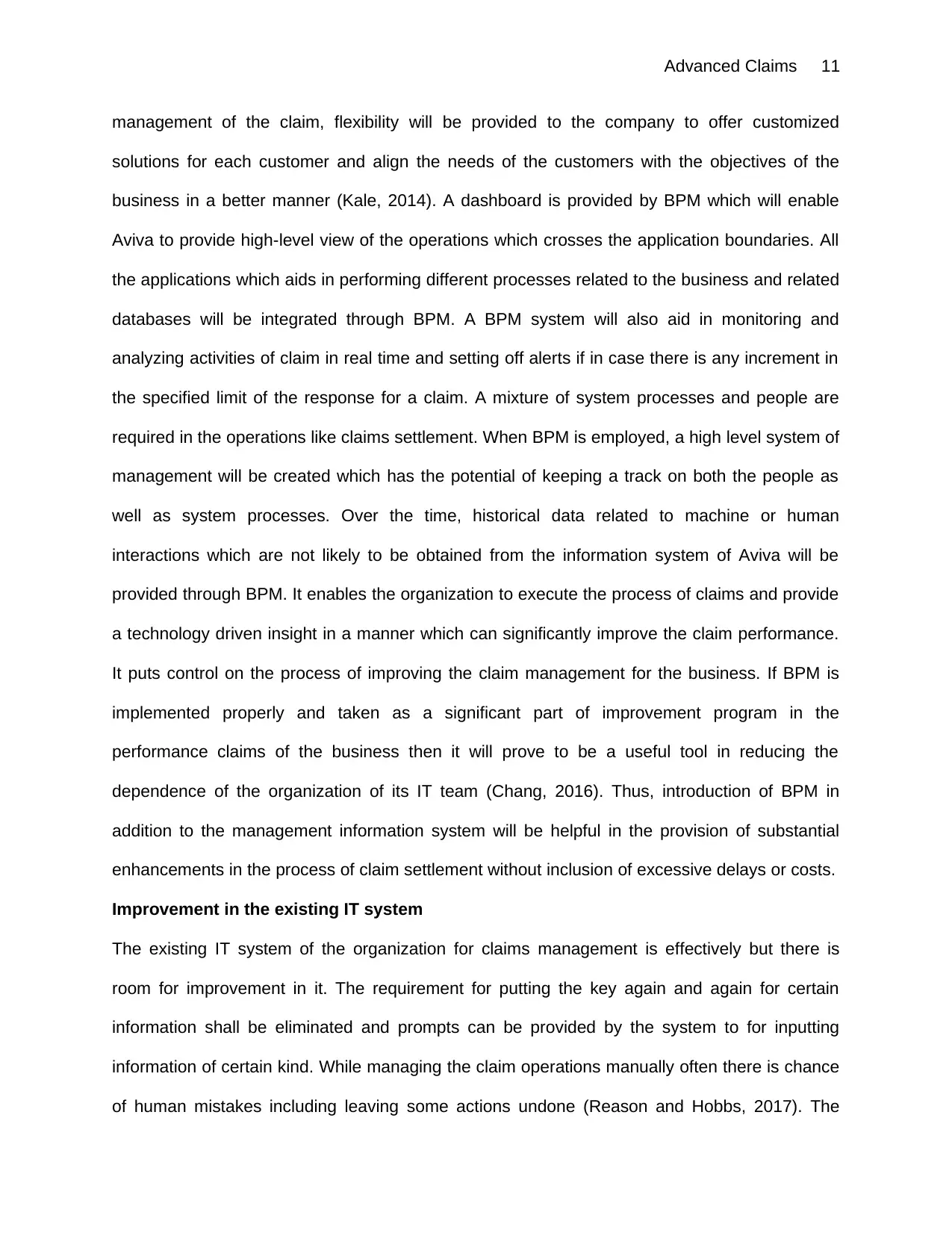
Advanced Claims 11
management of the claim, flexibility will be provided to the company to offer customized
solutions for each customer and align the needs of the customers with the objectives of the
business in a better manner (Kale, 2014). A dashboard is provided by BPM which will enable
Aviva to provide high-level view of the operations which crosses the application boundaries. All
the applications which aids in performing different processes related to the business and related
databases will be integrated through BPM. A BPM system will also aid in monitoring and
analyzing activities of claim in real time and setting off alerts if in case there is any increment in
the specified limit of the response for a claim. A mixture of system processes and people are
required in the operations like claims settlement. When BPM is employed, a high level system of
management will be created which has the potential of keeping a track on both the people as
well as system processes. Over the time, historical data related to machine or human
interactions which are not likely to be obtained from the information system of Aviva will be
provided through BPM. It enables the organization to execute the process of claims and provide
a technology driven insight in a manner which can significantly improve the claim performance.
It puts control on the process of improving the claim management for the business. If BPM is
implemented properly and taken as a significant part of improvement program in the
performance claims of the business then it will prove to be a useful tool in reducing the
dependence of the organization of its IT team (Chang, 2016). Thus, introduction of BPM in
addition to the management information system will be helpful in the provision of substantial
enhancements in the process of claim settlement without inclusion of excessive delays or costs.
Improvement in the existing IT system
The existing IT system of the organization for claims management is effectively but there is
room for improvement in it. The requirement for putting the key again and again for certain
information shall be eliminated and prompts can be provided by the system to for inputting
information of certain kind. While managing the claim operations manually often there is chance
of human mistakes including leaving some actions undone (Reason and Hobbs, 2017). The
management of the claim, flexibility will be provided to the company to offer customized
solutions for each customer and align the needs of the customers with the objectives of the
business in a better manner (Kale, 2014). A dashboard is provided by BPM which will enable
Aviva to provide high-level view of the operations which crosses the application boundaries. All
the applications which aids in performing different processes related to the business and related
databases will be integrated through BPM. A BPM system will also aid in monitoring and
analyzing activities of claim in real time and setting off alerts if in case there is any increment in
the specified limit of the response for a claim. A mixture of system processes and people are
required in the operations like claims settlement. When BPM is employed, a high level system of
management will be created which has the potential of keeping a track on both the people as
well as system processes. Over the time, historical data related to machine or human
interactions which are not likely to be obtained from the information system of Aviva will be
provided through BPM. It enables the organization to execute the process of claims and provide
a technology driven insight in a manner which can significantly improve the claim performance.
It puts control on the process of improving the claim management for the business. If BPM is
implemented properly and taken as a significant part of improvement program in the
performance claims of the business then it will prove to be a useful tool in reducing the
dependence of the organization of its IT team (Chang, 2016). Thus, introduction of BPM in
addition to the management information system will be helpful in the provision of substantial
enhancements in the process of claim settlement without inclusion of excessive delays or costs.
Improvement in the existing IT system
The existing IT system of the organization for claims management is effectively but there is
room for improvement in it. The requirement for putting the key again and again for certain
information shall be eliminated and prompts can be provided by the system to for inputting
information of certain kind. While managing the claim operations manually often there is chance
of human mistakes including leaving some actions undone (Reason and Hobbs, 2017). The
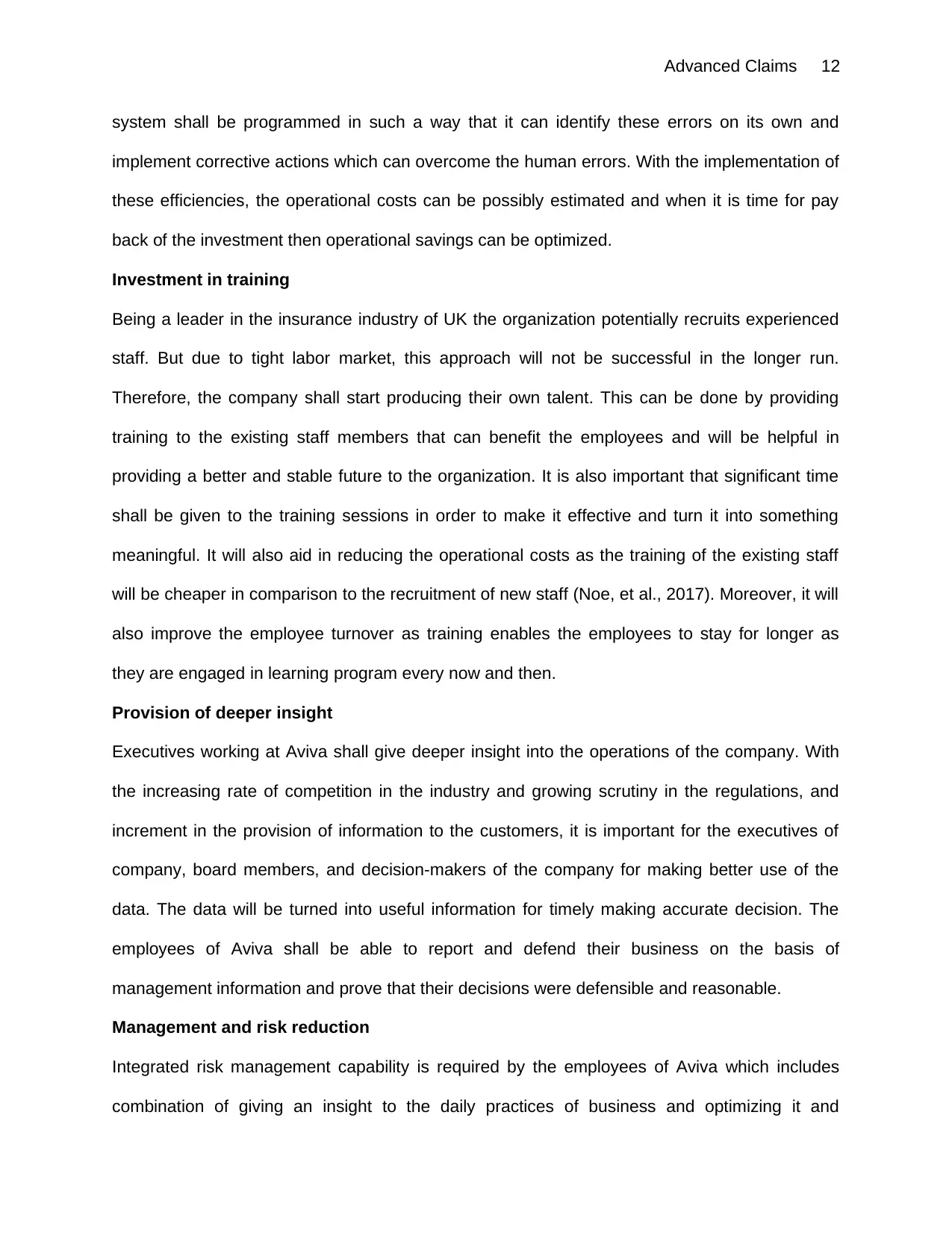
Advanced Claims 12
system shall be programmed in such a way that it can identify these errors on its own and
implement corrective actions which can overcome the human errors. With the implementation of
these efficiencies, the operational costs can be possibly estimated and when it is time for pay
back of the investment then operational savings can be optimized.
Investment in training
Being a leader in the insurance industry of UK the organization potentially recruits experienced
staff. But due to tight labor market, this approach will not be successful in the longer run.
Therefore, the company shall start producing their own talent. This can be done by providing
training to the existing staff members that can benefit the employees and will be helpful in
providing a better and stable future to the organization. It is also important that significant time
shall be given to the training sessions in order to make it effective and turn it into something
meaningful. It will also aid in reducing the operational costs as the training of the existing staff
will be cheaper in comparison to the recruitment of new staff (Noe, et al., 2017). Moreover, it will
also improve the employee turnover as training enables the employees to stay for longer as
they are engaged in learning program every now and then.
Provision of deeper insight
Executives working at Aviva shall give deeper insight into the operations of the company. With
the increasing rate of competition in the industry and growing scrutiny in the regulations, and
increment in the provision of information to the customers, it is important for the executives of
company, board members, and decision-makers of the company for making better use of the
data. The data will be turned into useful information for timely making accurate decision. The
employees of Aviva shall be able to report and defend their business on the basis of
management information and prove that their decisions were defensible and reasonable.
Management and risk reduction
Integrated risk management capability is required by the employees of Aviva which includes
combination of giving an insight to the daily practices of business and optimizing it and
system shall be programmed in such a way that it can identify these errors on its own and
implement corrective actions which can overcome the human errors. With the implementation of
these efficiencies, the operational costs can be possibly estimated and when it is time for pay
back of the investment then operational savings can be optimized.
Investment in training
Being a leader in the insurance industry of UK the organization potentially recruits experienced
staff. But due to tight labor market, this approach will not be successful in the longer run.
Therefore, the company shall start producing their own talent. This can be done by providing
training to the existing staff members that can benefit the employees and will be helpful in
providing a better and stable future to the organization. It is also important that significant time
shall be given to the training sessions in order to make it effective and turn it into something
meaningful. It will also aid in reducing the operational costs as the training of the existing staff
will be cheaper in comparison to the recruitment of new staff (Noe, et al., 2017). Moreover, it will
also improve the employee turnover as training enables the employees to stay for longer as
they are engaged in learning program every now and then.
Provision of deeper insight
Executives working at Aviva shall give deeper insight into the operations of the company. With
the increasing rate of competition in the industry and growing scrutiny in the regulations, and
increment in the provision of information to the customers, it is important for the executives of
company, board members, and decision-makers of the company for making better use of the
data. The data will be turned into useful information for timely making accurate decision. The
employees of Aviva shall be able to report and defend their business on the basis of
management information and prove that their decisions were defensible and reasonable.
Management and risk reduction
Integrated risk management capability is required by the employees of Aviva which includes
combination of giving an insight to the daily practices of business and optimizing it and
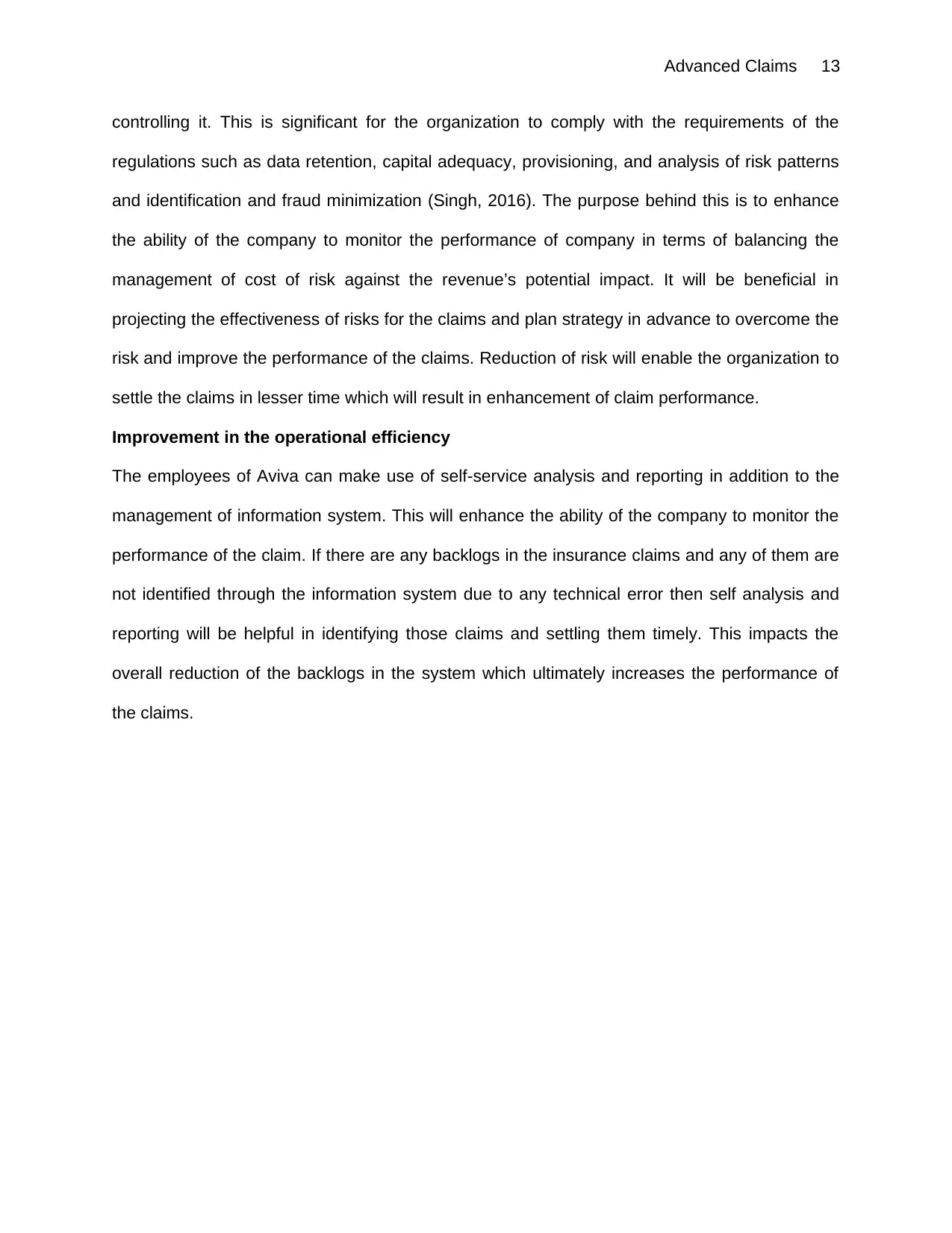
Advanced Claims 13
controlling it. This is significant for the organization to comply with the requirements of the
regulations such as data retention, capital adequacy, provisioning, and analysis of risk patterns
and identification and fraud minimization (Singh, 2016). The purpose behind this is to enhance
the ability of the company to monitor the performance of company in terms of balancing the
management of cost of risk against the revenue’s potential impact. It will be beneficial in
projecting the effectiveness of risks for the claims and plan strategy in advance to overcome the
risk and improve the performance of the claims. Reduction of risk will enable the organization to
settle the claims in lesser time which will result in enhancement of claim performance.
Improvement in the operational efficiency
The employees of Aviva can make use of self-service analysis and reporting in addition to the
management of information system. This will enhance the ability of the company to monitor the
performance of the claim. If there are any backlogs in the insurance claims and any of them are
not identified through the information system due to any technical error then self analysis and
reporting will be helpful in identifying those claims and settling them timely. This impacts the
overall reduction of the backlogs in the system which ultimately increases the performance of
the claims.
controlling it. This is significant for the organization to comply with the requirements of the
regulations such as data retention, capital adequacy, provisioning, and analysis of risk patterns
and identification and fraud minimization (Singh, 2016). The purpose behind this is to enhance
the ability of the company to monitor the performance of company in terms of balancing the
management of cost of risk against the revenue’s potential impact. It will be beneficial in
projecting the effectiveness of risks for the claims and plan strategy in advance to overcome the
risk and improve the performance of the claims. Reduction of risk will enable the organization to
settle the claims in lesser time which will result in enhancement of claim performance.
Improvement in the operational efficiency
The employees of Aviva can make use of self-service analysis and reporting in addition to the
management of information system. This will enhance the ability of the company to monitor the
performance of the claim. If there are any backlogs in the insurance claims and any of them are
not identified through the information system due to any technical error then self analysis and
reporting will be helpful in identifying those claims and settling them timely. This impacts the
overall reduction of the backlogs in the system which ultimately increases the performance of
the claims.
Paraphrase This Document
Need a fresh take? Get an instant paraphrase of this document with our AI Paraphraser
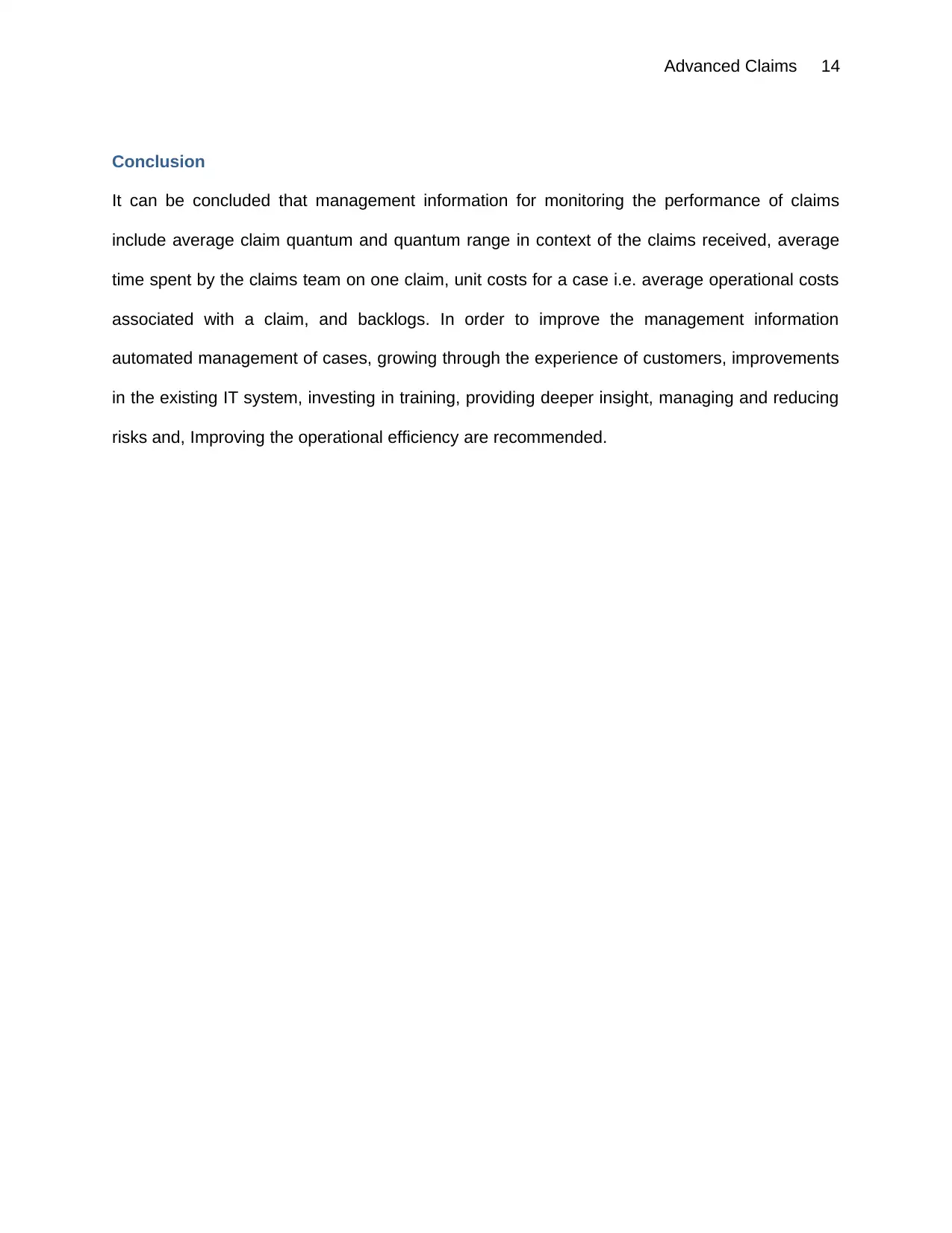
Advanced Claims 14
Conclusion
It can be concluded that management information for monitoring the performance of claims
include average claim quantum and quantum range in context of the claims received, average
time spent by the claims team on one claim, unit costs for a case i.e. average operational costs
associated with a claim, and backlogs. In order to improve the management information
automated management of cases, growing through the experience of customers, improvements
in the existing IT system, investing in training, providing deeper insight, managing and reducing
risks and, Improving the operational efficiency are recommended.
Conclusion
It can be concluded that management information for monitoring the performance of claims
include average claim quantum and quantum range in context of the claims received, average
time spent by the claims team on one claim, unit costs for a case i.e. average operational costs
associated with a claim, and backlogs. In order to improve the management information
automated management of cases, growing through the experience of customers, improvements
in the existing IT system, investing in training, providing deeper insight, managing and reducing
risks and, Improving the operational efficiency are recommended.
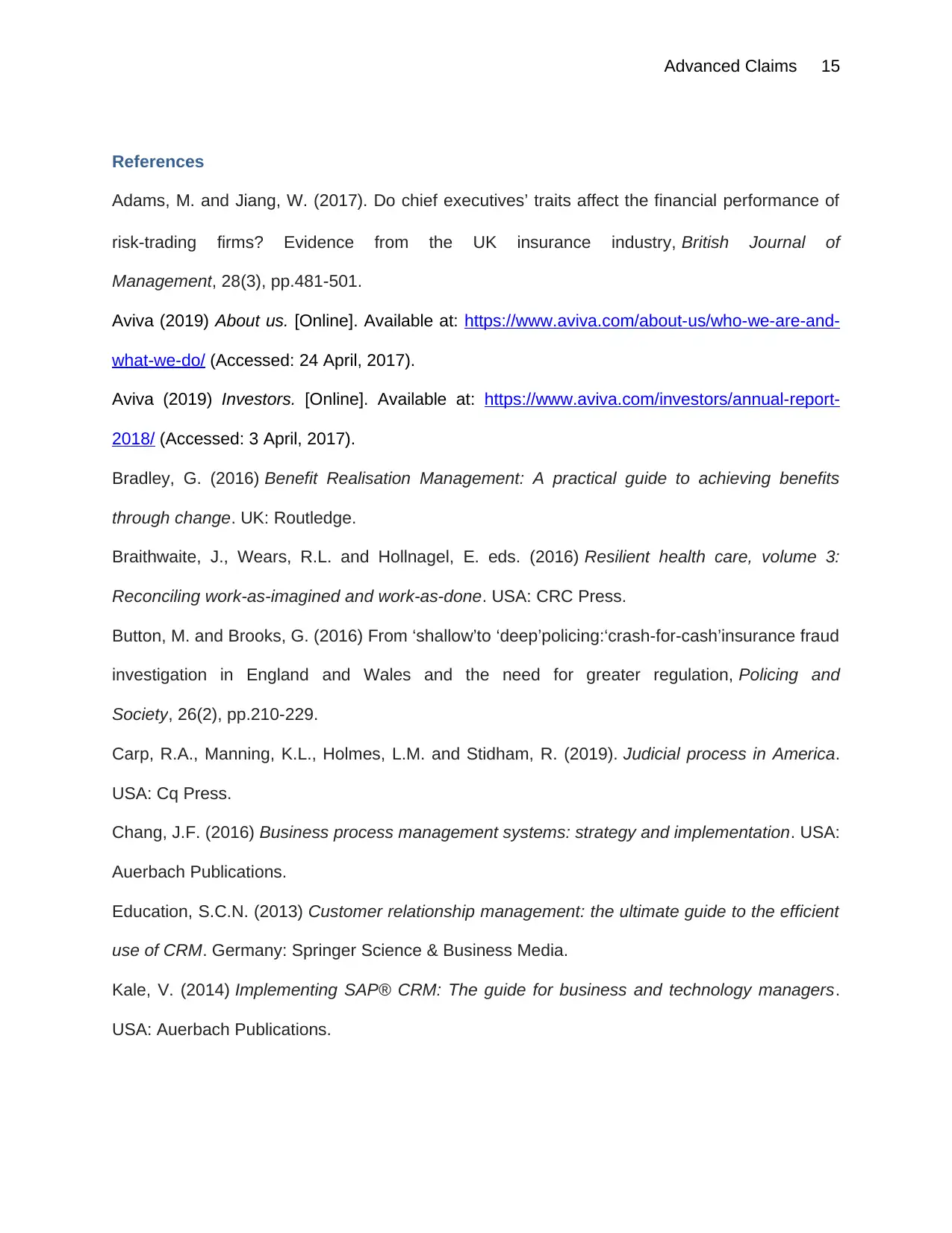
Advanced Claims 15
References
Adams, M. and Jiang, W. (2017). Do chief executives’ traits affect the financial performance of
risk‐trading firms? Evidence from the UK insurance industry, British Journal of
Management, 28(3), pp.481-501.
Aviva (2019) About us. [Online]. Available at: https://www.aviva.com/about-us/who-we-are-and-
what-we-do/ (Accessed: 24 April, 2017).
Aviva (2019) Investors. [Online]. Available at: https://www.aviva.com/investors/annual-report-
2018/ (Accessed: 3 April, 2017).
Bradley, G. (2016) Benefit Realisation Management: A practical guide to achieving benefits
through change. UK: Routledge.
Braithwaite, J., Wears, R.L. and Hollnagel, E. eds. (2016) Resilient health care, volume 3:
Reconciling work-as-imagined and work-as-done. USA: CRC Press.
Button, M. and Brooks, G. (2016) From ‘shallow’to ‘deep’policing:‘crash-for-cash’insurance fraud
investigation in England and Wales and the need for greater regulation, Policing and
Society, 26(2), pp.210-229.
Carp, R.A., Manning, K.L., Holmes, L.M. and Stidham, R. (2019). Judicial process in America.
USA: Cq Press.
Chang, J.F. (2016) Business process management systems: strategy and implementation. USA:
Auerbach Publications.
Education, S.C.N. (2013) Customer relationship management: the ultimate guide to the efficient
use of CRM. Germany: Springer Science & Business Media.
Kale, V. (2014) Implementing SAP® CRM: The guide for business and technology managers.
USA: Auerbach Publications.
References
Adams, M. and Jiang, W. (2017). Do chief executives’ traits affect the financial performance of
risk‐trading firms? Evidence from the UK insurance industry, British Journal of
Management, 28(3), pp.481-501.
Aviva (2019) About us. [Online]. Available at: https://www.aviva.com/about-us/who-we-are-and-
what-we-do/ (Accessed: 24 April, 2017).
Aviva (2019) Investors. [Online]. Available at: https://www.aviva.com/investors/annual-report-
2018/ (Accessed: 3 April, 2017).
Bradley, G. (2016) Benefit Realisation Management: A practical guide to achieving benefits
through change. UK: Routledge.
Braithwaite, J., Wears, R.L. and Hollnagel, E. eds. (2016) Resilient health care, volume 3:
Reconciling work-as-imagined and work-as-done. USA: CRC Press.
Button, M. and Brooks, G. (2016) From ‘shallow’to ‘deep’policing:‘crash-for-cash’insurance fraud
investigation in England and Wales and the need for greater regulation, Policing and
Society, 26(2), pp.210-229.
Carp, R.A., Manning, K.L., Holmes, L.M. and Stidham, R. (2019). Judicial process in America.
USA: Cq Press.
Chang, J.F. (2016) Business process management systems: strategy and implementation. USA:
Auerbach Publications.
Education, S.C.N. (2013) Customer relationship management: the ultimate guide to the efficient
use of CRM. Germany: Springer Science & Business Media.
Kale, V. (2014) Implementing SAP® CRM: The guide for business and technology managers.
USA: Auerbach Publications.
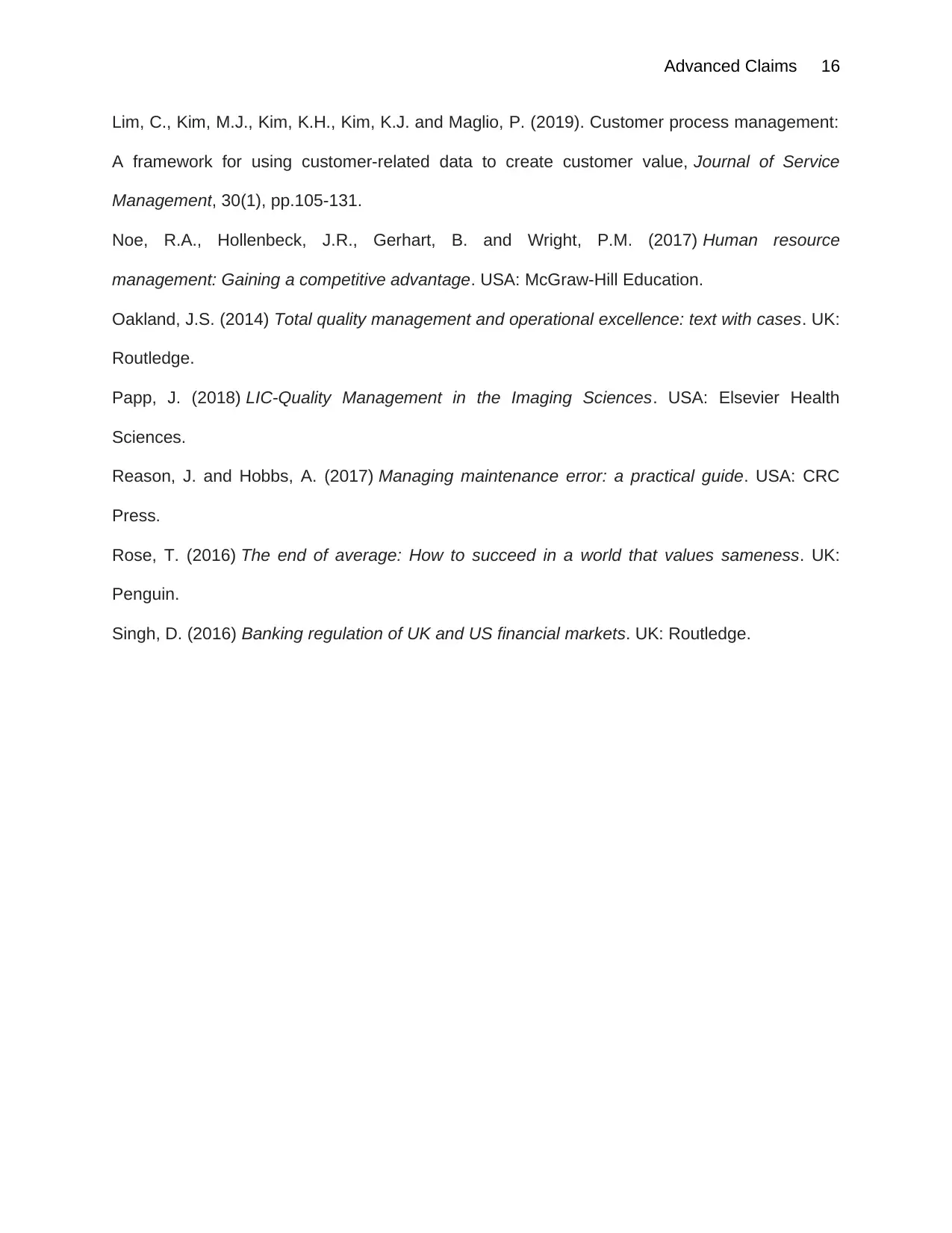
Advanced Claims 16
Lim, C., Kim, M.J., Kim, K.H., Kim, K.J. and Maglio, P. (2019). Customer process management:
A framework for using customer-related data to create customer value, Journal of Service
Management, 30(1), pp.105-131.
Noe, R.A., Hollenbeck, J.R., Gerhart, B. and Wright, P.M. (2017) Human resource
management: Gaining a competitive advantage. USA: McGraw-Hill Education.
Oakland, J.S. (2014) Total quality management and operational excellence: text with cases. UK:
Routledge.
Papp, J. (2018) LIC-Quality Management in the Imaging Sciences. USA: Elsevier Health
Sciences.
Reason, J. and Hobbs, A. (2017) Managing maintenance error: a practical guide. USA: CRC
Press.
Rose, T. (2016) The end of average: How to succeed in a world that values sameness. UK:
Penguin.
Singh, D. (2016) Banking regulation of UK and US financial markets. UK: Routledge.
Lim, C., Kim, M.J., Kim, K.H., Kim, K.J. and Maglio, P. (2019). Customer process management:
A framework for using customer-related data to create customer value, Journal of Service
Management, 30(1), pp.105-131.
Noe, R.A., Hollenbeck, J.R., Gerhart, B. and Wright, P.M. (2017) Human resource
management: Gaining a competitive advantage. USA: McGraw-Hill Education.
Oakland, J.S. (2014) Total quality management and operational excellence: text with cases. UK:
Routledge.
Papp, J. (2018) LIC-Quality Management in the Imaging Sciences. USA: Elsevier Health
Sciences.
Reason, J. and Hobbs, A. (2017) Managing maintenance error: a practical guide. USA: CRC
Press.
Rose, T. (2016) The end of average: How to succeed in a world that values sameness. UK:
Penguin.
Singh, D. (2016) Banking regulation of UK and US financial markets. UK: Routledge.
1 out of 16
Related Documents
Your All-in-One AI-Powered Toolkit for Academic Success.
+13062052269
info@desklib.com
Available 24*7 on WhatsApp / Email
![[object Object]](/_next/static/media/star-bottom.7253800d.svg)
Unlock your academic potential
© 2024 | Zucol Services PVT LTD | All rights reserved.




